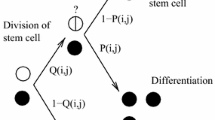Abstract
Growth-fragmentation equations arise in many different contexts, ranging from cell division, protein polymerization, neurosciences etc. Direct observation of temporal dynamics being often difficult, it is of main interest to develop theoretical and numerical methods to recover reaction rates and parameters of the equation from indirect observation of the solution. Following the work done in Perthame and Zubelli (Inverse Probl 23:1037–1052, 2007) and Doumic et al. (2009) for the specific case of the cell division equation, we address here the general question of recovering the fragmentation rate of the equation from the observation of the time-asymptotic solution, when the fragmentation kernel and the growth rates are fully general. We give both theoretical results and numerical methods, and discuss the remaining issues.
Similar content being viewed by others
References
Brézis H (1983) Functional analysis. Masson, Paris
Doumic M, Perthame B, Zubelli JP (2009) Numerical solution of an inverse problem in size-structured population dynamics. Inverse Probl 25(4). doi:10.1088/0266-5611/25/4/045008
Doumic M, Maia P, Zubelli JP (2010) On the calibration of a size-structured population model from experimental data. Acta Biotheor 58(4): 405–413
Doumic M, Gabriel P (2010) Eigenelements of a general aggregation-fragmentation model
Doumic M, Hoffmann M, Reynaud-Bouret P, Rivoirard V Nonparametric estimation of the division rate of a size-structured population. (submitted)
Engl HW, Hanke M, Neubauer A (1996) Regularization of inverse problems, volume 375 of mathematics and its applications. Kluwer, Dordrecht
Greer ML, Pujo-Menjouet L, Webb GF (2006) A mathematical analysis of the dynamics of prion proliferation. J Theor Biol 242: 598–606
Groh A, Krebs J, Wagner M (2011) Efficient solution of an inverse problem in cell population dynamics. Inverse Probl 27
Gyllenberg M, Osipov A, Päivärinta L (2002) The inverse problem of age-structured population dynamics. J Evol Equ 2: 222–239
Hardy GH, Littlewood JE, Polya G (1988) Inequalities. Cambride Mathematical Library, Cambridge
Heijmans HJAM (1984) On the stable size distribution of populations reproducing by fission into two inequal parts. Math Biosci 72(1): 19–50
Metz JAJ, Diekmann O (1986) The dynamics of physiologically structured populations, Lecture Notes in Biomathematics 68. Springer, Berlin
Michel P, Mischler , Perthame B (2005) General entropy equations for structured population models and scattering. C R Math Acad Sci Paris 338(9): 697–702
Perthame B (2007) Transport equations in biology. Frontiers in mathematics. Birkhäuser Verlag, Basel
Perthame B, Ryzhik L (2005) Exponential decay for the fragmentation or cell-division equation. J Differ Equ 210(1): 155–177
Perthame B, Zubelli JP (2007) On the inverse problem for a size structured population model. Inverse Probl 23: 1037–1052
Author information
Authors and Affiliations
Corresponding author
Rights and permissions
About this article
Cite this article
Doumic, M., Tine, L.M. Estimating the division rate for the growth-fragmentation equation. J. Math. Biol. 67, 69–103 (2013). https://doi.org/10.1007/s00285-012-0553-6
Received:
Revised:
Published:
Issue Date:
DOI: https://doi.org/10.1007/s00285-012-0553-6
Keywords
- Growth-fragmentation equation
- Cell division equation
- General fragmentation kernels
- Inverse problem
- Eigenvalue problem




